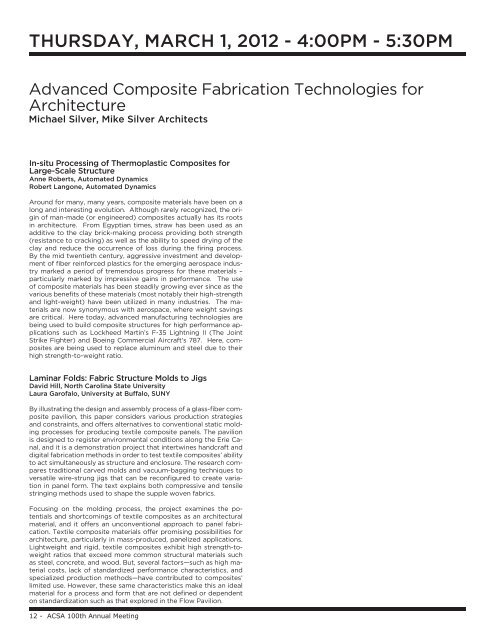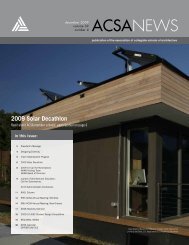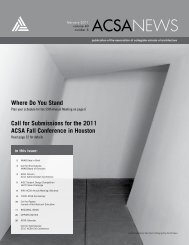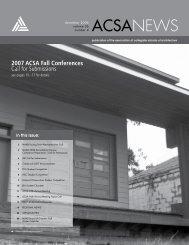digital aptitudes - Association of Collegiate Schools of Architecture
digital aptitudes - Association of Collegiate Schools of Architecture
digital aptitudes - Association of Collegiate Schools of Architecture
You also want an ePaper? Increase the reach of your titles
YUMPU automatically turns print PDFs into web optimized ePapers that Google loves.
THURSDAY, MARCH 1, 2012 - 4:00PM - 5:30PM<br />
Advanced Composite Fabrication Technologies for<br />
<strong>Architecture</strong><br />
Michael Silver, Mike Silver Architects<br />
In-situ Processing <strong>of</strong> Thermoplastic Composites for<br />
Large-Scale Structure<br />
Anne Roberts, Automated Dynamics<br />
Robert Langone, Automated Dynamics<br />
Around for many, many years, composite materials have been on a<br />
long and interesting evolution. Although rarely recognized, the origin<br />
<strong>of</strong> man-made (or engineered) composites actually has its roots<br />
in architecture. From Egyptian times, straw has been used as an<br />
additive to the clay brick-making process providing both strength<br />
(resistance to cracking) as well as the ability to speed drying <strong>of</strong> the<br />
clay and reduce the occurrence <strong>of</strong> loss during the firing process.<br />
By the mid twentieth century, aggressive investment and development<br />
<strong>of</strong> fiber reinforced plastics for the emerging aerospace industry<br />
marked a period <strong>of</strong> tremendous progress for these materials –<br />
particularly marked by impressive gains in performance. The use<br />
<strong>of</strong> composite materials has been steadily growing ever since as the<br />
various benefits <strong>of</strong> these materials (most notably their high-strength<br />
and light-weight) have been utilized in many industries. The materials<br />
are now synonymous with aerospace, where weight savings<br />
are critical. Here today, advanced manufacturing technologies are<br />
being used to build composite structures for high performance applications<br />
such as Lockheed Martin’s F-35 Lightning II (The Joint<br />
Strike Fighter) and Boeing Commercial Aircraft’s 787. Here, composites<br />
are being used to replace aluminum and steel due to their<br />
high strength-to-weight ratio.<br />
Laminar Folds: Fabric Structure Molds to Jigs<br />
David Hill, North Carolina State University<br />
Laura Gar<strong>of</strong>alo, University at Buffalo, SUNY<br />
By illustrating the design and assembly process <strong>of</strong> a glass-fiber composite<br />
pavilion, this paper considers various production strategies<br />
and constraints, and <strong>of</strong>fers alternatives to conventional static molding<br />
processes for producing textile composite panels. The pavilion<br />
is designed to register environmental conditions along the Erie Canal,<br />
and it is a demonstration project that intertwines handcraft and<br />
<strong>digital</strong> fabrication methods in order to test textile composites’ ability<br />
to act simultaneously as structure and enclosure. The research compares<br />
traditional carved molds and vacuum-bagging techniques to<br />
versatile wire-strung jigs that can be reconfigured to create variation<br />
in panel form. The text explains both compressive and tensile<br />
stringing methods used to shape the supple woven fabrics.<br />
Focusing on the molding process, the project examines the potentials<br />
and shortcomings <strong>of</strong> textile composites as an architectural<br />
material, and it <strong>of</strong>fers an unconventional approach to panel fabrication.<br />
Textile composite materials <strong>of</strong>fer promising possibilities for<br />
architecture, particularly in mass-produced, panelized applications.<br />
Lightweight and rigid, textile composites exhibit high strength-toweight<br />
ratios that exceed more common structural materials such<br />
as steel, concrete, and wood. But, several factors—such as high material<br />
costs, lack <strong>of</strong> standardized performance characteristics, and<br />
specialized production methods—have contributed to composites’<br />
limited use. However, these same characteristics make this an ideal<br />
material for a process and form that are not defined or dependent<br />
on standardization such as that explored in the Flow Pavilion.<br />
12 - ACSA 100th Annual Meeting








